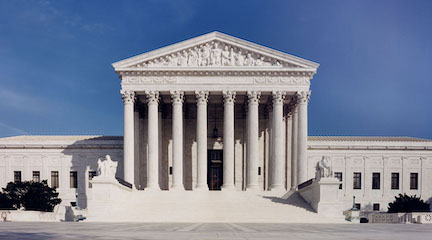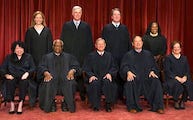 |
A Vacancy on the Court | < |
The Media
The media have always played a prominent role in Supreme Court nominations, perhaps no more so than in 1795 when newspaper reports of a speech by John Rutledge, George Washington's choice to replace the first Chief Justice, John Jay, revealed that Rutledge had delivered a public address in which he criticized the Jay Treaty, declaring among other things that it would be better if Washington were dead than accept the conditions of this treaty. That, along with other reports regarding certain erratic behaviors of Rutledge, led the Senate to reject his nomination for Chief Justice. This section used to be entitled "The Press," but convergence of print journalism with audio and video news media occuring in the twenty-first century has vastly expanded the world of journalism and provided new outlets for partisan scripts. We now use "media" to refer to journalists and their outlets regardless of their reporting medium. Journalists are critical to the nomination and confirmation process because they do much to define and constrain the discourse of the process. Their characterizations of the nominee, of the issues arising from a particular nomination, of the responses by senators, advocacy groups, and other elites are all significant in influencing how the public will perceive the nomination. It's hard for opponents of a nomination to generate and sustain public opposition if the media do not prominently recognize and report consistently on the controversy over the nominee. But that's precisely the job of journalists—determining the legitimacy of the claims of proponents and opponents and deciding when opposition is sufficiently widespread and serious to be newsworthy. In addition to the journalists who report the nomination and confirmation as news, there are the pundits who analyze, evaluate, and provide varied viewpoints about the nominee and those involved in the nomination and confirmation process. What we as citizens need to do is to use the media to help us understand what's happening and what the issues are. This requires critical reading (listening and viewing) of journalists and pundits, making an independent assessment of how well they are covering the process. Learn to distinguish between those in the media who are essentially advocates in behalf of or in opposition to the president and those who are more faithful to a journalistic ideal of impartiality. There are some excellent journalists, analysts, and pundits out there. Many are connected with the prestige press: the New York Times, Washington Post, Wall Street Journal, and National Public Radio, among others. However, USA Today and the news weekly magazines generally have very good coverage of the Supreme Court nomination and confirmation process as well. Even so, as we have said elsewhere ( Shaping America: The Politics of Supreme Court Appointments), “News reporting is not, in fact, reporting reality, it is constructing reality. Reporters, analysts, and editors are constantly confronted with the necessity of making decisions concerning what events and actions constitute news, how to construct descriptions of that news, and empowering individuals as credible spokespersons for these events and actions. In the news business, every decision, whether it be to commit or omit, has political consequences. Even basic journalistic ethics, which seek to insure fairness by providing balanced and reliable coverage, cannot overcome the fundamental arbitrariness of journalistic decision-making.” As a news consumer, you must pay attention to what is omitted from a story as well as what is included. The Washington Post is certainly not considered a bastion of conservatism, but consider its two-part front page analysis that immediately preceded the Clarence Thomas confirmation hearings. The first installment headlined “Thomas: Growing Up Black in a White World”. It followed the next day with “Despite Achievement, Thomas Felt Isolated; Rebuffs Stung Emerging Conservative”. Analysis features may not constitute “news”, but they do represent what newspapers feel they do better than the other media, namely, provide an in-depth assessment of a news topic. What do these headlines and the stories that were fairly represented by them suggest about the Thomas nomination? They framed the nomination as one that focused on the character and race of Clarence Thomas. Attempts by some to focus on Thomas's lack of experience, intellectual capacity, and judicial temperament were largely absent from the Post analysis, effectively nonissues. From the perspective of Thomas opponents, these analyses might as well have been written by White House staff. (adapted from Shaping America: The Politics of Supreme Court Appointments) |